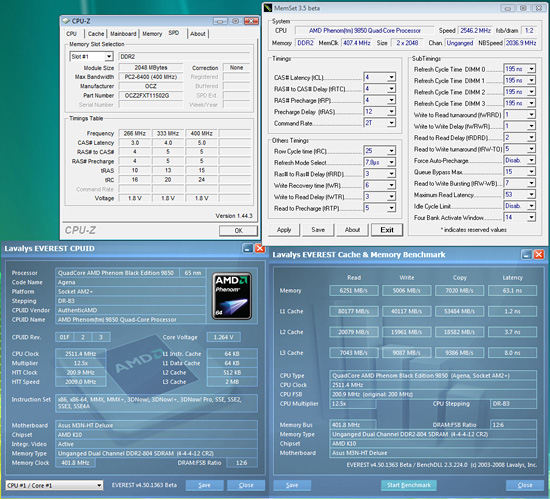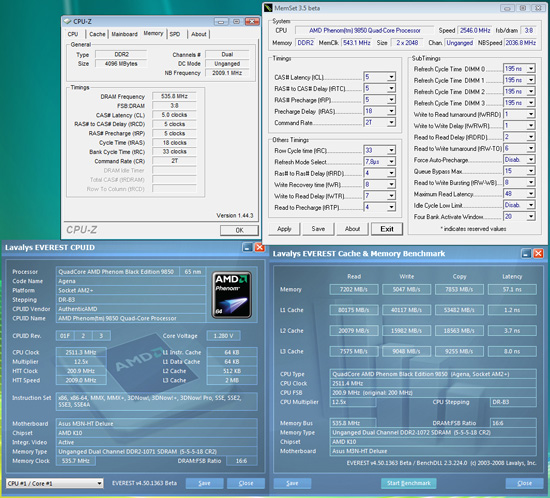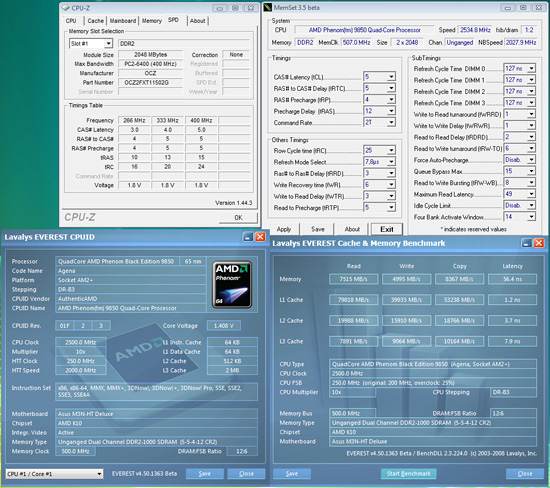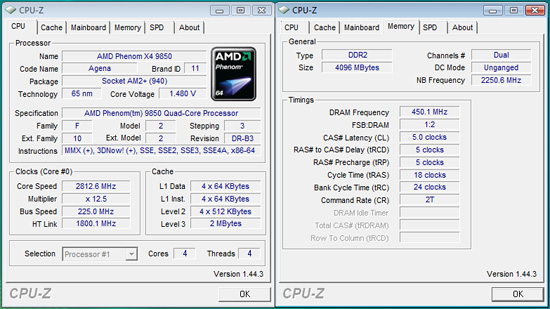NVIDIA 780a: Integrated Graphics and SLI in One
by Gary Key on May 6, 2008 12:00 AM EST- Posted in
- CPUs
Memory and Overclocking Performance
One of the most disappointing aspects of testing the ASUS M3N-HT Deluxe board was the general lack of compatibility with most of the 2GB modules at our disposal. The first few BIOS releases would rarely run a 2x2GB configuration in a stable manner and a 4x2GB setup was out of the question. The last BIOS release allowed us to complete our benchmarking sessions with a standard 4GB setup and 8GB was usable with one particular part from G.Skill. However, this board would lock immediately if you manually changed the settings for the onboard video memory from auto to a manual selection. The good news is that ASUS has replicated several of our problems and we expect a new BIOS release shortly for use in the motherboard review.
In the meantime, we are providing three test results with our memory at DDR2-800 and DDR2-1066 at stock processor settings along with a DDR2-1000 setting with an HTT overclock to 250 while retaining the same base CPU speed. DDR2-1066 operation was not always stable with 4GB or even 2GB for that matter, but we were able to complete our benchmark tests after relaxing several timings and increasing memory voltage from 2.0 to 2.1V. Overall, DDR2-1066 performance provided slightly improved latencies along with better read and copy throughput. Initial test results with several applications show a slight improvement of 1%~3% at stock CPU settings.
We wanted to show direct comparisons to the 790FX platform along with scaling and performance oriented timings, but the stability of the board with 4GB setups is just not to a point yet where we can guarantee 24/7 stability with performance oriented setups. We hope the BIOS updates from ASUS will address this quickly. Our initial testing with the MSI K9N2 Diamond board indicates this problem is strictly BIOS related as 4GB configurations are working well so far on this board.
Our most disappointing results with the board were during our overclocking tests. We constantly had to fight the 4GB memory problems and finally switched over to 2GB without much success either. This particular setup would only operate around 2.8GHz stable but required 1.48V and relaxed memory timings to reach this level.
Our particular CPU sample has done 3.3GHz at the same voltages on the 790FX platform. After discussions with NVIDIA and ASUS, the feel our current overclocking maladies are BIOS related at this time. We tend to believe them as manually setting the CPU voltage resulted in the board applying an additional 0.10V to the CPU. We noticed several other settings that would overvolt at various times but the CPU voltage was consistent and bothersome.
After a few days of trying to clock this board to meet the standards set by the 790FX platform, we decided to call it quits until the next BIOS release. One item worth mentioning is the BIOS design and options opened up by ASUS is nothing short of spectacular, especially in the memory timing section. We will go into more detail in the motherboard review, but if the memory, voltage, and OC problems are properly addressed, this should be one special board for Phenom overclockers.














38 Comments
View All Comments
SiliconDoc - Monday, July 28, 2008 - link
Very glad this happens : " The good news is that ASUS has replicated several of our problems and we expect a new BIOS release shortly for use in the motherboard review. "That's what I call useful review that isn't a waste of time. Glad you have the reputation and the pull. ( one wonders what they do at Acer - I guess they wait for you guys to tell them...)
piroroadkill - Sunday, May 11, 2008 - link
I agree with the guys who are saying they need to make discrete (not discreet, jesus) GPUs consume much less power when idling, even if that means a hybridpower style segmentation of the gpu, but it should be done all on the hardware, completely transparent to the chipset and systemKGR - Saturday, May 10, 2008 - link
Maybe hybrid sli doesnt help frame rates too much , but it can make sense when nvidia integrates the Ageia pysics in gpu, then the mgpu can take the load of physics and the dgpu the graphics in hybrid mode, i dont know if it is possible but i think it is...duploxxx - Thursday, May 8, 2008 - link
Always like to read the reviews and comments from your site, but why don't you just provide proof with real data instead of a hit in the dark. You already have big parts of the data in an other review.(http://www.anandtech.com/video/showdoc.aspx?i=3232...">http://www.anandtech.com/video/showdoc.aspx?i=3232...
" Whether or not this price tag is worth the premium over the nForce 750a SLI boards is up for debate. It's not really in our opinion as we do not believe the current AMD processor series is capable of the required computational power needed to support 3-way SLI or Quad SLI configurations. This is not a knock against NVIDIA as AMD has the same problem with Quad CrossFire; it just reflects the current state of the processor offerings from AMD."
why don't you just put 9750-9850+790fx+2-3way crossfire against q6600/q9300+x38+2-3way and compare total price/performance/power but perhaps need to add a x48 board since the lack of pci-e lanes on the x38
you could do the same with lower spec P35 but then again this board has no decent feature set against current amd chipset offerings when you talk about multi gpu setup but would still be interesting to read what happens when using CF on this board against amd770
gipper - Wednesday, May 7, 2008 - link
So why isn't the 750a going to be the perfect HTPC motherboard?Aren't the two requirements for the perfect HTPC motherboard native 1080p output via HDMI and 7.1 LPCM audio on the same HDMI connector? Also, the post processing with a phenom matches the AMD 780 chip feature set.
So, I don't understand why you would say that the AMD 780 is better for HTPC's.
Or are you guys suggesting that it's best to wait for the AMD 780 refresh that includes 7.1 LPCM because the integrated graphics perform so much better?
Gary Key - Thursday, May 8, 2008 - link
I personally believe the 750a would make an excellent HTPC system if you utilize a ATX case design, might plan on using it for gaming with a discreet video card, and can afford it. The GF8300 board that just arrived is a better solution at first glance (if a uATX design and not having SLI capability is important) and compares favorably to the 780G from a price to performance viewpoint, more so than the GF8200. We will have an update on it next week.We received the 175.16 drivers right after the article went live and will have some post-processing comparisons (174.14s did not handle this right) this weekend between the two chipsets. Right now, it is a toss up in my opinion, and due to that fact, I would go NV for the multi-channel LPCM.
The Jedi - Wednesday, May 7, 2008 - link
A couple of points here:[QUOTE]
This is absolutely unacceptable and would prevent us from recommending the 780a as anything more than just another SLI motherboard. HybridPower is quite possibly the best feature for a high-end SLI user and if it won't work with 30" displays then its usefulness is severely degraded.
[/QUOTE]
I'll tell ya I use a 26" LCD TV on my desktop and it's big enough. I don't need 2560x1600. 1080p (1200p) is fine and matches the pixels on HDTV. Anything 1080p capable is completely reasonable. Just up the AA or AF if the FPS are too fast for ya. Just because Dell or Apple says Uber-users need a 30-inch LCD to be cool doesn't make it true. 24", 26", 27", these are great on today's desks. I really think a 30" LCD on my desk would be too big.
Gary Key, you da man, seriously, but proofread the article for typos.
Last point, and this goes for all of Anandtech's staff: Respect due, but seriously: NO dGPU. Call it A VIDEO CARD. Or -- A GRAPHICS CARD. Also, no calling a product from a CPU or GPU company a 'part' . Call it a chip -- or a CPU or a graphics chip, etc.
strikeback03 - Thursday, May 8, 2008 - link
I'd love to see a 2560x1600 24-26" display, the more resolution the better. If that 9 megapixel LCD weren't several thousand dollars it would be sweet.Wolfcastle - Wednesday, May 7, 2008 - link
The author should clean up the grammar a bit. Anandtech has a large audience.James5mith - Wednesday, May 7, 2008 - link
Maybe I'm just foolish here, but for the extreme overclocking crowd, I see an immediate and tangible benefit:If you happen to fry your video card while OC'ing it, you can use the onboard video as a stopgap until you get it repaired.